A Fast Fault Identification in a Grid-Connected Photovoltaic System Using Wavelet Multi-Resolution Singular Spectrum Entropy and Support Vector Machine
Abstract
:1. Introduction
2. Theoretical Background
2.1. Discrete Wavelet Transform
2.2. Multi-Resolution Singular Spectrum Entropy
2.3. Support Vector Machine
- Step 1.
- The values of C and γ parameters are specified experimentally by a grid search and cross-validation process.
- Step 2.
- The values of C and γ parameters are changed in increments of the power of 2.
- Step 3.
- A k-fold validation is used for any parameter combination. The training data set is partitioned into k subsamples of equal size. k – 1 subsamples from the whole of k subsamples are utilized as the training data, and only the remaining subsample is applied as validation data.
- Step 4.
- The cross-validation process is iterated k times, and SVM is trained by all subsamples except the validation data.
- Step 5.
- The trained SVM is tested only via the validation data, and the classification error for this subsample is computed.
- Step 6.
- The training subsamples are tested separately once and the percentage of correct classification is calculated as the cross-validation accuracy.
- Step 7.
- To select the best value combinations of C and γ parameters, this process is repeated until the best pair gives the maximum assessment accuracy.
3. Proposed Protection Scheme
- Step 1.
- The three-phase voltage signals at the PCC are measured for different types of grid faults by simulating a three-phase grid-tied photovoltaic system in a Matlab/Simulink (r2015a, Mathworks, Natick, MA, USA) environment.
- Step 2.
- A suitable mother wavelet is selected and the number of levels of decomposition is determined. In this paper, Daubechies 4 (DB4) was designated as the mother wavelet by experimentation and trial and error and the measured PCC voltage signals were decomposed by eight layers.
- Step 3.
- The reconstruction voltage signals of each layer are reconstructed in the phase space. In this article, the number of sampling points is . The n-dimensional phase space is 2970-dimensional. Hence, matrix is reconstructed into dimensions.
- Step 4.
- Matrix is decomposed by singular value decomposition in order to compute the singular spectrum entropy of each layer. So, 2970 singular values of each layer are obtained.
- Step 5.
- The entropy value of each layer, e.g., , is calculated.
- Step 6.
- The extracted for different types of grid faults are collected in vector and used to train the SVM classifier:
- Step 7.
- The grid faults are detected and classified by SVM.
- Step 8.
- A command block diagram is considered to specify whether a fault occurs or not. The proposed fault detection technique transfers a “trip signal is set to 1” command if fault cases are predicted; otherwise, for normal conditions a “trip signal is set to 0” command is set.
4. System Model and Simulation Results
4.1. Studied System
- At the PCC location;
- At two different distances of 8 km and 14 km away from the PV system.
- The type of fault conditions are as follows:
- Single phase to ground fault (SP-G);
- Phase to phase to ground fault (PP-G);
- Three phase to ground fault (PPP-G);
- Phase to phase fault (PTP).
- The grid faults occurred at t = 0.3 s, and after 150 ms they were cleared.
4.2. Simulation Results
5. Performance of SVM Classifier and Comparative Examination
6. Investigation of PV Operation under Different Fault Conditions
7. Discussions
8. Conclusions
Author Contributions
Funding
Conflicts of Interest
Nomenclature
| PV | Photovoltaic |
| PCC | Point of common coupling |
| DG | Distributed generation |
| DWT | Discrete wavelet transform |
| SVM | Support vector machine |
| Discrete signal | |
| Mother wavelet | |
| Discrete mother wavelet | |
| MRA | Multi-resolution analysis |
| MRSSE | Multi-resolution singular spectrum entropy |
| WMRSSE | Wavelet multi-resolution singular spectrum entropy |
| Low-pass filter | |
| High-pass filter | |
| Approximate parts | |
| Detailed parts | |
| Decomposition layer | |
| Coefficient vector | |
| Dual operator of | |
| Dual operator of | |
| Nonzero diagonal element | |
| Information entropy of level | |
| Undefined probability distribution of the nonzero diagonal elements | |
| Weight vector normal to hyperplane | |
| Bias | |
| Slack variable | |
| Kernel function | |
| RBF | Radial basis function |
| SP-G | Single phase to ground fault |
| PP-G | Phase to phase to ground fault |
| PPP-G | Three phase to ground fault |
| PTP | Phase to phase fault |
| SNR | Signal to noise ratio |
| PWM | Pulse-width modulation |
| PLL | Phase locked loop |
| VSC | Voltage source control |
References
- Jäger-Waldau, A. Snapshot of photovoltaics—March 2017. Sustainability 2017, 9, 783. [Google Scholar] [CrossRef]
- Masson, G.; Latour, M.; Biancardi, D. Global Market Outlook for Photovoltaics until 2016; EPIA–European Photovoltaic Industry Association: Bruxelas, Belgium, 2012. [Google Scholar]
- Colli, A. Failure mode and effect analysis for photovoltaic systems. Renew. Sustain Energy Rev. 2015, 50, 804–809. [Google Scholar] [CrossRef]
- Alam, M.K.; Khan, F.; Johnson, J.; Flicker, J. A comprehensive review of catastrophic faults in PV arrays: Types, detection, and mitigation techniques. IEEE J. Photovolt. 2015, 59, 82–97. [Google Scholar] [CrossRef]
- Falvo, M.C.; Capparella, S. Safety issues in PV systems: Design choices for a secure fault detection and for preventing fire risk. Case Stud. Fire Saf. 2015, 3, 1–6. [Google Scholar] [CrossRef]
- Mellit, A.; Tina, G.M.; Kalogirou, S.A. Fault detection and diagnosis methods for photovoltaic systems: A review. Renew. Sustain. Energy Rev. 2018, 91, 1–7. [Google Scholar] [CrossRef]
- Van der Walt, H.L.; Bansal, R.C.; Naidoo, R. PV based distributed generation power system protection: A review. Renew. Energy Focus 2018, 24, 33–40. [Google Scholar] [CrossRef]
- Madeti, S.R.; Singh, S.N. A comprehensive study on different types of faults and detection techniques for solar photovoltaic system. Sol. Energy 2017, 158, 161–185. [Google Scholar] [CrossRef]
- Gururajapathy, S.S.; Mokhlis, H.; Illias, H.A. Fault location and detection techniques in power distribution systems with distributed generation: A review. Renew. Sustain. Energy Rev. 2017, 74, 949–958. [Google Scholar] [CrossRef]
- Freitas, W.; Xu, W.; Affonso, C.M.; Huang, Z. Comparative analysis between ROCOF and vector surge relays for distributed generation applications. IEEE Trans. Power Deliv. 2005, 20, 1315–1324. [Google Scholar] [CrossRef]
- Freitas, W.; Xu, W. False operation of vector surge relays. IEEE Trans. Power Deliv. 2004, 19, 436–438. [Google Scholar] [CrossRef]
- Xin-min, T.; Wan-Hai, C.; Bao-Xiang, D.; Han-Guang, D. A Novel Model of one-class Bearing Fault Detection using RNCS Algorithm based on HOS. In Proceedings of the 2007 2nd IEEE Conference on Industrial Electronics and Applications, Harbin, China, 23 May 2007; pp. 965–970. [Google Scholar]
- Ndou, R.; Fadiran, J.I.; Chowdhury, S.; Chowdhury, S.P. Performance comparison of voltage and frequency based loss of grid protection schemes for microgrids. In Proceedings of the 2013 IEEE Power & Energy Society General Meeting, Vancouver, BC, Canada, 21 July 2013; pp. 1–5. [Google Scholar]
- Wang, G.; Youn, C.C.; Stankovic, A.M. DC-side high impedance ground fault detection for transformerless single-phase PV systems. In Proceedings of the 2015 North American Power Symposium (NAPS), Charlotte, NC, USA, 4 October 2015; pp. 1–6. [Google Scholar] [CrossRef]
- He, Q.; Blum, R.S. New hypothesis testing-based methods for fault detection for smart grid systems. In Proceedings of the 2011 45th Annual Conference on Information Sciences and Systems, Baltimore, MD, USA, 23–25 March 2011; pp. 1–6. [Google Scholar] [CrossRef]
- Chybowski, L. Application of External Events Vectors for Defining Reliability Structure of Fishing Vessels Power, Propulsion and Technological Plants. Pol. J. Environ. Stud. 2009, 18, 45–50. [Google Scholar]
- Ahmadipour, M.; Hizam, H.; Othman, M.L.; Radzi, M.A.; Murthy, A.S. Islanding detection technique using Slantlet Transform and Ridgelet Probabilistic Neural Network in grid-connected photovoltaic system. Appl. Energy. 2018, 231, 645–659. [Google Scholar] [CrossRef]
- Dehghani, M.; Khooban, M.H.; Niknam, T. Fast fault detection and classification based on a combination of wavelet singular entropy theory and fuzzy logic in distribution lines in the presence of distributed generations. Int. J. Electr. Power Energy Syst. 2016, 78, 455–462. [Google Scholar] [CrossRef]
- Ahmadipour, M.; Hizam, H.; Lutfi Othman, M.; Amran Mohd Radzi, M. An Anti-Islanding Protection Technique Using a Wavelet Packet Transform and a Probabilistic Neural Network. Energies 2018, 11, 2701. [Google Scholar] [CrossRef]
- Chiacchio, F.; Famoso, F.; D’Urso, D.; Brusca, S.; Aizpurua, J.; Cedola, L. Dynamic performance evaluation of photovoltaic power plant by stochastic hybrid fault tree automaton model. Energies 2018, 11, 306. [Google Scholar] [CrossRef]
- Chaitanya, B.K.; Yadav, A. An intelligent fault detection and classification scheme for distribution lines integrated with distributed generators. Comput. Electr. Eng. 2018, 69, 28–40. [Google Scholar] [CrossRef]
- Dashti, R.; Ghasemi, M.; Daisy, M. Fault location in power distribution network with presence of distributed generation resources using impedance based method and applying π line model. Energy 2018, 159, 344–360. [Google Scholar] [CrossRef]
- Yi, Z.; Etemadi, A.H. Fault detection for photovoltaic systems based on multi-resolution signal decomposition and fuzzy inference systems. IEEE Trans. Smart Grid 2017, 8, 1274–1283. [Google Scholar] [CrossRef]
- Kuo, C.L.; Chen, J.L.; Chen, S.J.; Kao, C.C.; Yau, H.T.; Lin, C.H. Photovoltaic energy conversion system fault detection using fractional-order color relation classifier in microdistribution systems. IEEE Trans. Smart Grid 2017, 8, 1163–1172. [Google Scholar] [CrossRef]
- Kumar, B.P.; Ilango, G.S.; Reddy, M.J.; Chilakapati, N. Online fault detection and diagnosis in photovoltaic systems using wavelet packets. IEEE J. Photovolt. 2018, 8, 257–265. [Google Scholar] [CrossRef]
- Xia, K.; He, S.; Tan, Y.; Jiang, Q.; Xu, J.; Yu, W. Wavelet packet and support vector machine analysis of series DC ARC fault detection in photovoltaic system. IEEJ Trans. Electr. Electron. Eng. 2019, 14, 192–200. [Google Scholar] [CrossRef]
- Baghli, M.; Delpha, C.; Diallo, D.; Hallouche, A.; Mba, D.; Wang, T. Three-Level NPC Inverter Incipient Fault Detection and Classification using Output Current Statistical Analysis. Energies 2019, 12, 1372. [Google Scholar] [CrossRef]
- Zhu, Q.; Li, Z.; Tan, X.; Xie, D.; Dai, W. Sensors Fault Diagnosis and Active Fault-Tolerant Control for PMSM Drive Systems Based on a Composite Sliding Mode Observer. Energies 2019, 12, 1695. [Google Scholar] [CrossRef]
- Dasgupta, A.; Nath, S.; Das, A. Transmission line fault classification and location using wavelet entropy and neural network. Electr. Power Compon. Syst. 2012, 40, 1676–1689. [Google Scholar] [CrossRef]
- Khokhar, S.; Zin, A.A.; Memon, A.P.; Mokhtar, A.S. A new optimal feature selection algorithm for classification of power quality disturbances using discrete wavelet transform and probabilistic neural network. Measurement 2017, 95, 246–259. [Google Scholar] [CrossRef]
- Mallat, SG. A theory for multiresolution signal decomposition: The wavelet representation. IEEE Trans. Pattern Anal. Mach. Intell. 1989, 11, 674–693. [Google Scholar] [CrossRef]
- Jahedi, G.; Ardehali, M.M. Wavelet based artificial neural network applied for energy efficiency enhancement of decoupled HVAC system. Energy Convers. Manag. 2012, 54, 47–56. [Google Scholar] [CrossRef]
- Kong, X.; Xu, X.; Yan, Z.; Chen, S.; Yang, H.; Han, D. Deep learning hybrid method for islanding detection in distributed generation. Appl. Energy 2018, 210, 776–785. [Google Scholar] [CrossRef]
- Cortes, C.; Vapnik, V. Support-vector networks. Mach. Learn. 1995, 20, 237–297. [Google Scholar] [CrossRef]
- Cristianini, N.; Shawe-Taylor, J. An Introduction to Support Vector Machines and Other Kernel-Based Learning Methods; Cambridge University Press: London, UK, 2000. [Google Scholar]
- Samet, H.; Hashemi, F.; Ghanbari, T. Minimum non detection zone for islanding detection using an optimal Artificial Neural Network algorithm based on PSO. Renew. Sustain. Energy Rev. 2015, 52, 1–8. [Google Scholar] [CrossRef]
- Shahid, N.; Aleem, S.A.; Naqvi, I.H.; Zaffar, N. Support vector machine based fault detection & classification in smart grids. In Proceedings of the 2012 IEEE Globecom Workshops, Anaheim, CA, USA, 3–7 December 2012; pp. 1526–1531. [Google Scholar] [CrossRef]
- Laagoubi, T.; Bouzi, M.; Benchagra, M. MPPT and power factor control for grid connected PV systems with fuzzy logic controllers. Int. J. Power Electron. Drive Syst. 2018, 9, 105. [Google Scholar] [CrossRef]
- Wang, N.; Aravinthan, V.; Ding, Y. Feeder-level fault detection and classification with multiple sensors: A smart grid scenario. In Proceedings of the 2014 IEEE Workshop on Statistical Signal Processing (SSP), Gold Coast, Australia, 29 June–2 July 2014; pp. 37–40. [Google Scholar] [CrossRef]
- Klomjit, J.; Ngaopitakkul, A. Selection of proper input pattern in fuzzy logic algorithm for classifying the fault type in underground distribution system. In Proceedings of the 2016 IEEE Region 10 Conference (TENCON), Singapore, 22–25 November 2016; pp. 2650–2655. [Google Scholar] [CrossRef]
- Shafiullah, M.; Abido, M.A. S-Transform based FFNN approach for distribution grids fault detection and classification. IEEE Access 2018, 6, 8080–8088. [Google Scholar] [CrossRef]
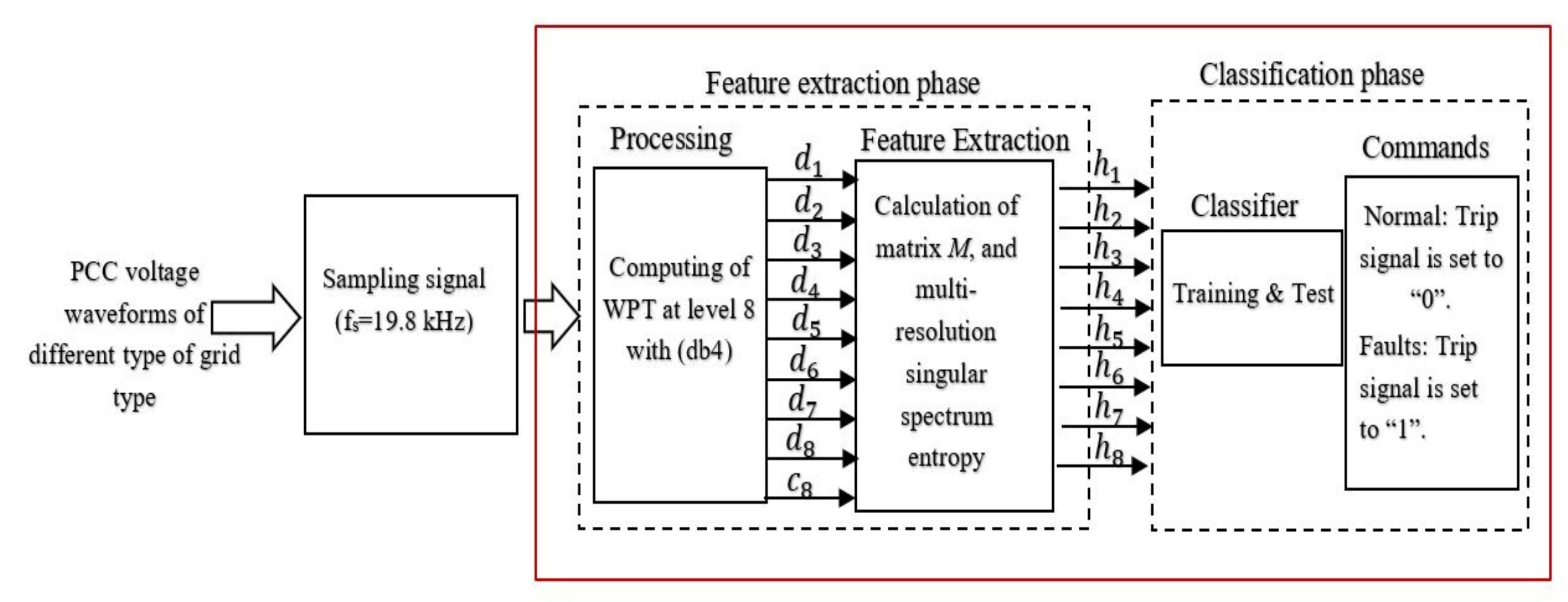
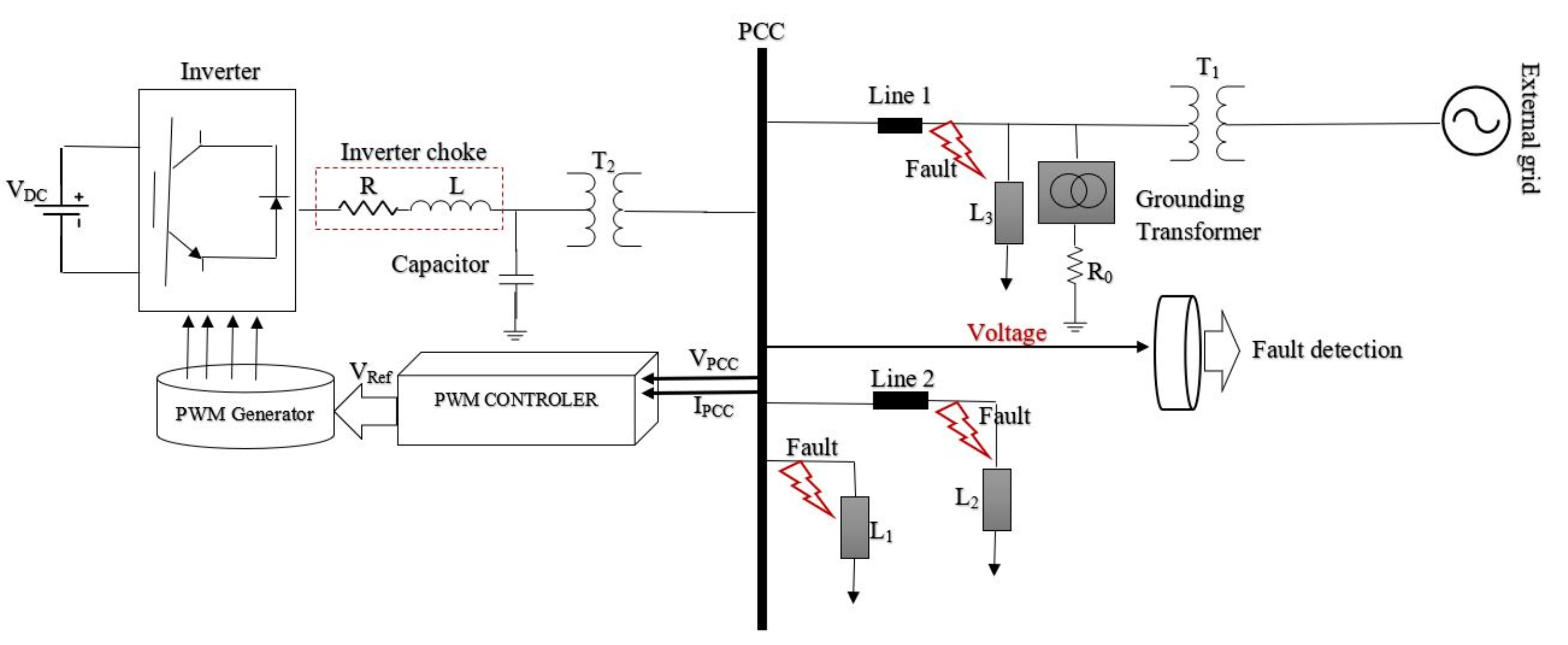

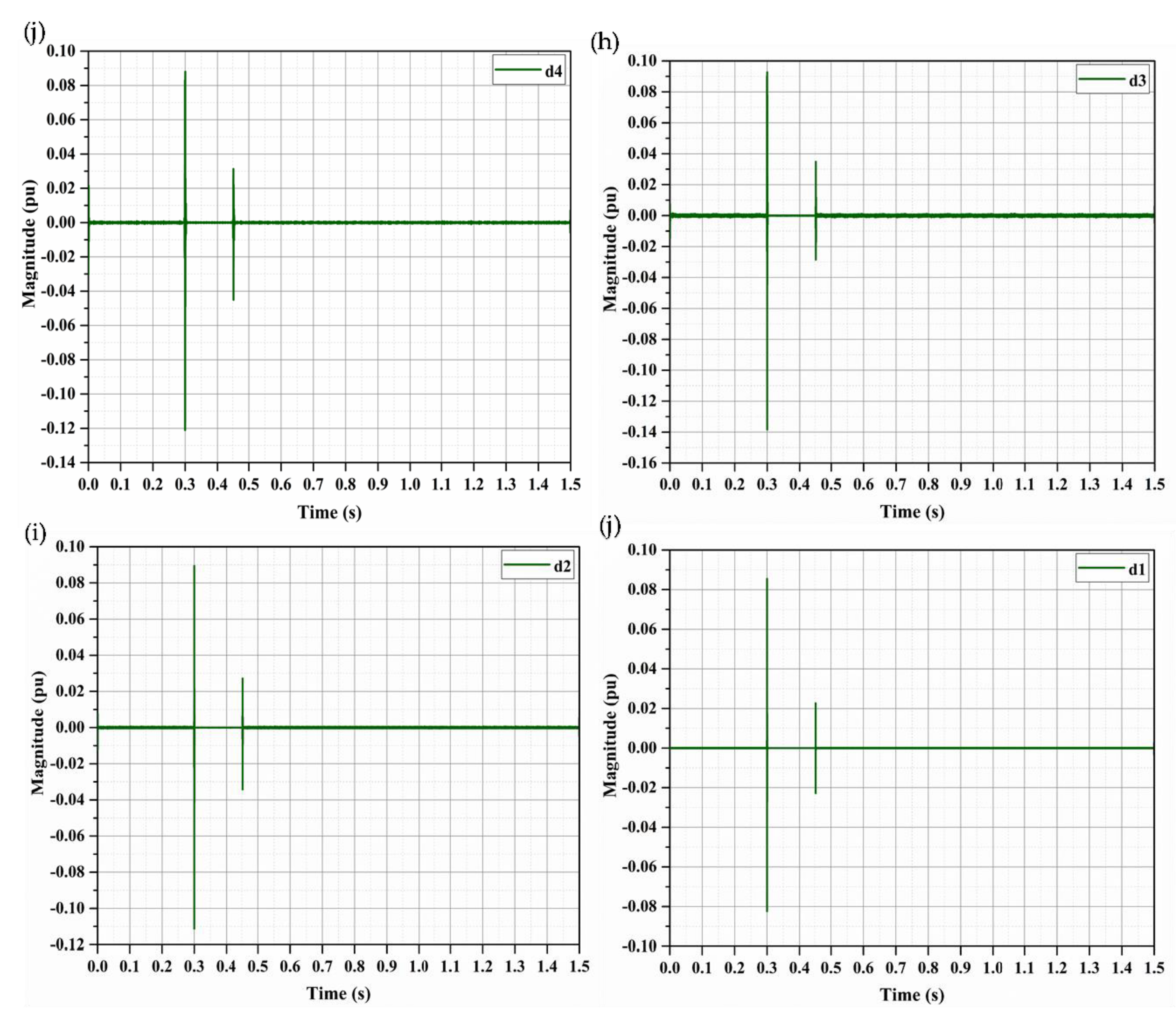
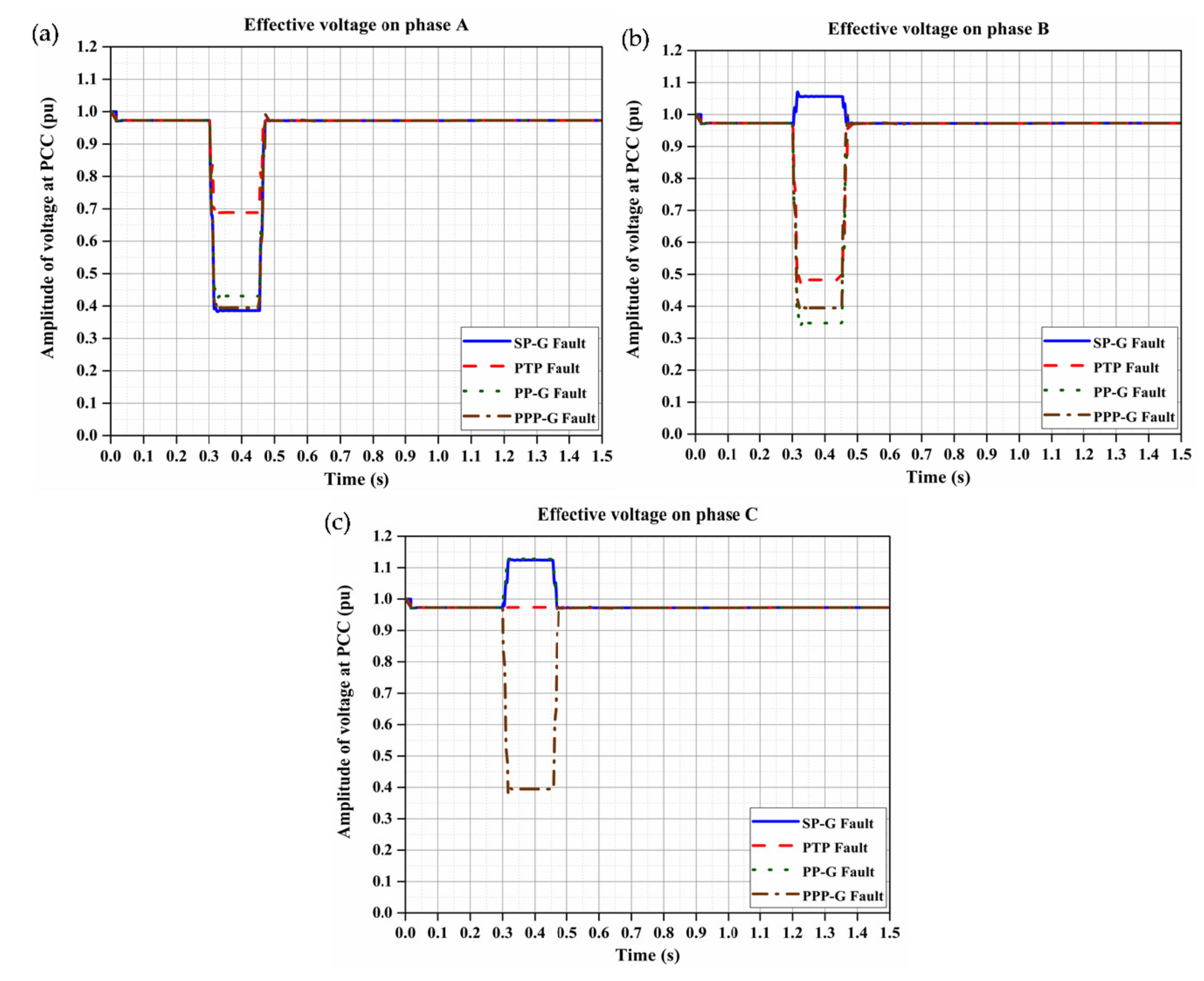
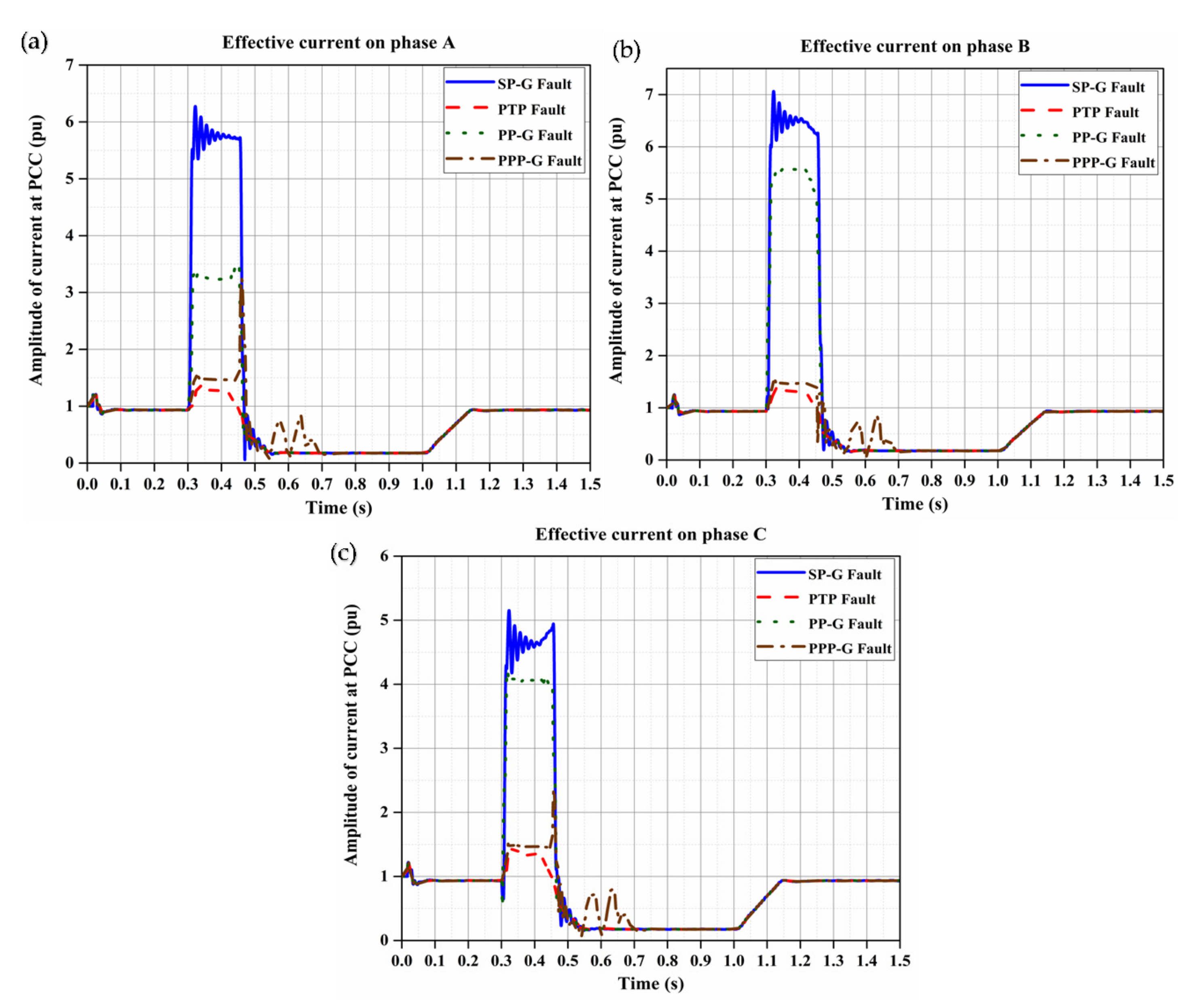

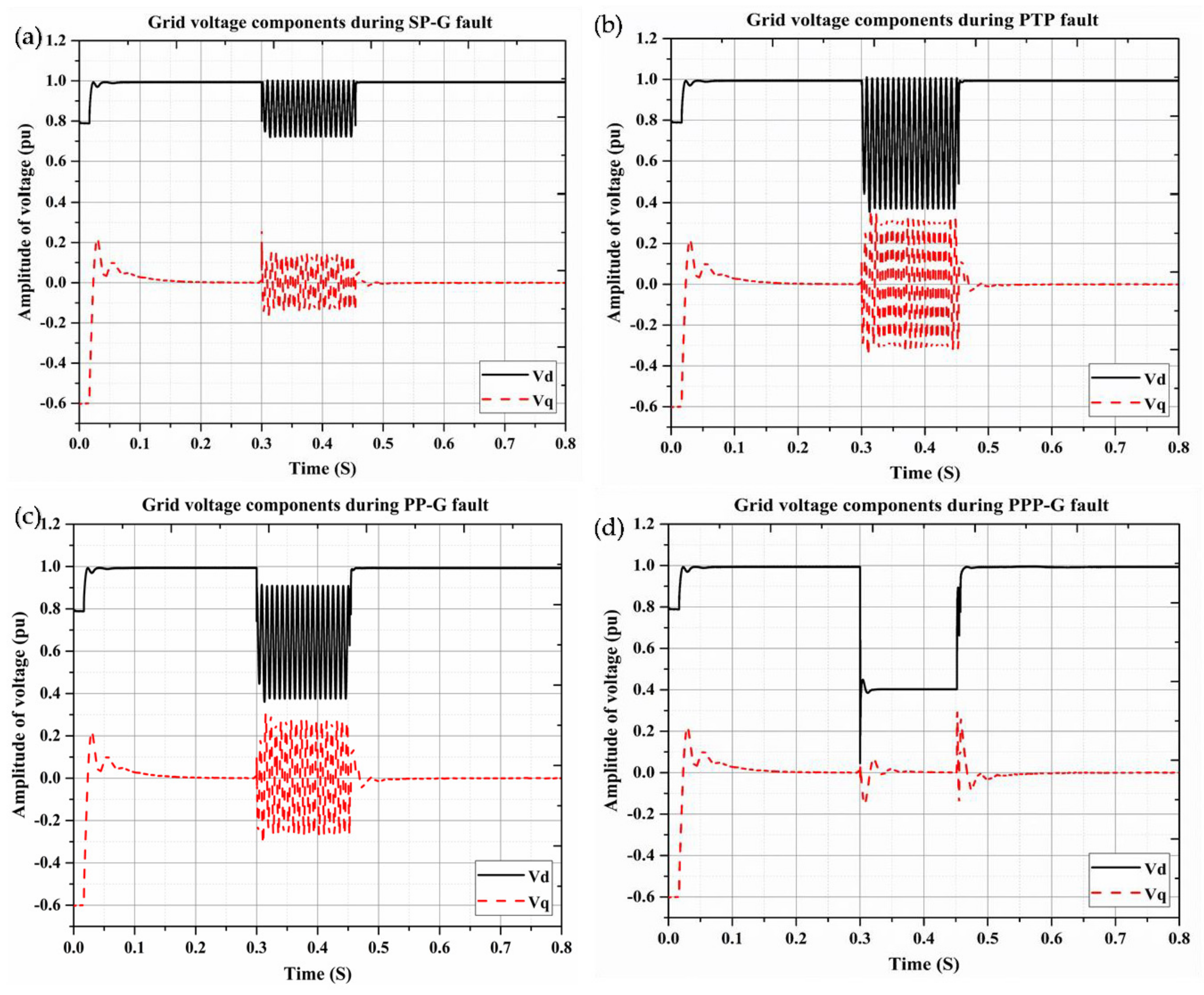
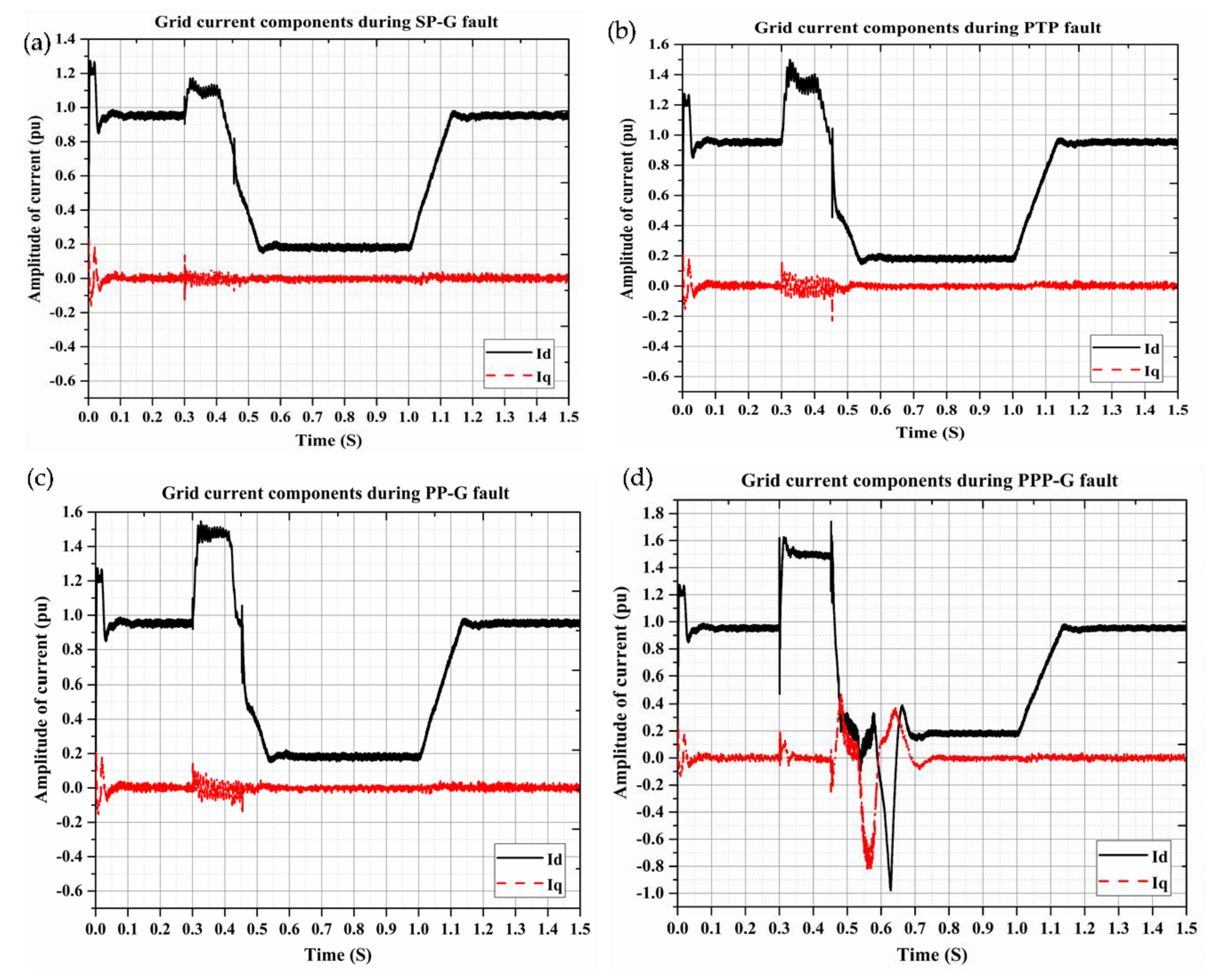

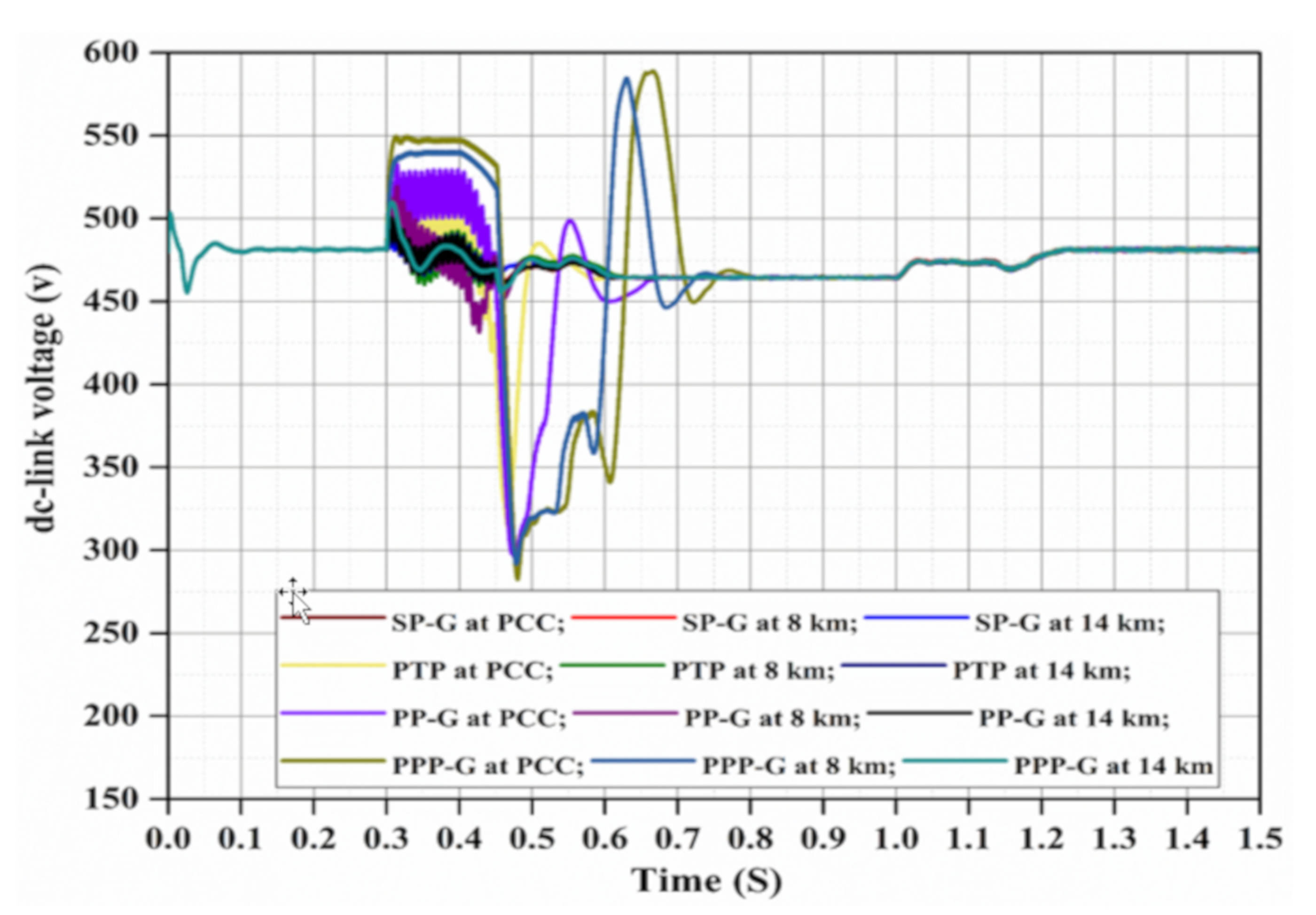

| Cases | Fault Type | h1 | h2 | h3 | h4 | h5 | h6 | h7 | h8 |
|---|---|---|---|---|---|---|---|---|---|
| Single phase to ground fault | A-G | 1.651916 | 1.81376 | 2.087569 | 2.240375 | 2.332471 | 1.822076 | 1.515768 | 1.212614 |
| B-G | 1.584156 | 1.675841 | 1.985808 | 2.192021 | 2.289222 | 1.791597 | 1.490412 | 1.19233 | |
| C-G | 1.605848 | 1.707286 | 2.019093 | 2.209135 | 2.323937 | 1.823147 | 1.516659 | 1.213327 | |
| Phases to phase fault | AB | 2.281622 | 2.333029 | 2.626407 | 3.022257 | 3.175512 | 2.51777 | 2.094509 | 1.675608 |
| AC | 2.194732 | 2.310459 | 2.763754 | 3.040323 | 3.174181 | 2.457786 | 2.044609 | 1.635687 | |
| BC | 2.192187 | 2.311252 | 2.765803 | 3.037306 | 3.172545 | 2.455789 | 2.042948 | 1.634358 | |
| Phase to phase to ground fault | AB-G | 2.4201 | 2.528262 | 2.846191 | 3.275166 | 3.441246 | 2.728463 | 2.269783 | 1.815826 |
| AC-G | 2.378392 | 2.503803 | 2.995031 | 3.294744 | 3.439804 | 2.663459 | 2.215706 | 1.772565 | |
| BC-G | 2.375634 | 2.504663 | 2.997252 | 3.291475 | 3.438031 | 2.661295 | 2.213906 | 1.771125 | |
| Three phase to ground fault | ABC-G | 3.69408 | 4.056001 | 4.668304 | 5.010014 | 5.215963 | 4.074597 | 3.389619 | 2.711695 |
| Normal | - | 0.567916 | 0.623556 | 0.71769 | 0.770223 | 0.801885 | 0.626415 | 0.521109 | 0.416887 |
| Cases | Fault Type | h1 | h2 | h3 | h4 | h5 | h6 | h7 | h8 |
|---|---|---|---|---|---|---|---|---|---|
| SP-G | A-G | 1.856042 | 2.037885 | 2.345528 | 2.517216 | 2.620692 | 2.047228 | 1.70307 | 1.362456 |
| B-G | 1.779908 | 1.882924 | 2.231192 | 2.462886 | 2.572099 | 2.012982 | 1.674581 | 1.339665 | |
| C-G | 1.804281 | 1.918254 | 2.268591 | 2.482116 | 2.611104 | 2.048431 | 1.704071 | 1.363257 | |
| PTP | AB | 2.563559 | 2.621319 | 2.95095 | 3.395714 | 3.567907 | 2.828888 | 2.353326 | 1.882661 |
| AC | 2.465933 | 2.59596 | 3.105268 | 3.416012 | 3.566412 | 2.761492 | 2.297259 | 1.837807 | |
| BC | 2.463073 | 2.596851 | 3.107571 | 3.412623 | 3.564573 | 2.759248 | 2.295393 | 1.836314 | |
| PP-G | AB-G | 2.71915 | 2.840677 | 3.197892 | 3.679875 | 3.866477 | 3.065616 | 2.550258 | 2.040206 |
| AC-G | 2.672288 | 2.813196 | 3.365124 | 3.701872 | 3.864857 | 2.99258 | 2.489499 | 1.991599 | |
| BC-G | 2.669189 | 2.814162 | 3.36762 | 3.698199 | 3.862865 | 2.990148 | 2.487476 | 1.989981 | |
| PPP-G | ABC-G | 4.150553 | 4.557197 | 5.245161 | 5.629096 | 5.860494 | 4.57809 | 3.808471 | 3.046777 |
| Cases | Fault Type | F-Measure (%) | Accuracy (%) | ||||||
|---|---|---|---|---|---|---|---|---|---|
| C = 8; = 0.125 | |||||||||
| SP-G | A-G | 75.55556 | 82.75862 | 88.37209 | 100 | 98.44156 | 98.97436 | 99.49109 | 100 |
| B-G | 77.77778 | 82.75862 | 88.37209 | 100 | 98.70466 | 98.97436 | 99.49109 | 100 | |
| C-G | 77.77778 | 82.35294 | 88.09524 | 100 | 98.70466 | 98.72123 | 99.23858 | 100 | |
| PTP | AB | 78.65169 | 85.05747 | 88.09524 | 100 | 98.70801 | 99.23274 | 99.23858 | 100 |
| AC | 78.65169 | 82.75862 | 88.37209 | 100 | 98.70801 | 98.97436 | 99.49109 | 100 | |
| BC | 76.92308 | 82.35294 | 89.41176 | 100 | 98.7013 | 98.72123 | 99.49239 | 100 | |
| PP-G | AB-G | 79.12088 | 83.33333 | 91.76471 | 100 | 98.96373 | 98.72449 | 99.74684 | 100 |
| AC-G | 75.55556 | 83.33333 | 91.76471 | 100 | 98.44156 | 98.72449 | 99.74684 | 100 | |
| BC-G | 75.55556 | 85.71429 | 92.68293 | 100 | 98.44156 | 98.98219 | 99.49622 | 100 | |
| PPP-G | ABC-G | 79.12088 | 90.2439 | 97.56098 | 100 | 98.96373 | 99.24242 | 100 | 100 |
| Cases | Classification Accuracy | Detection Accuracy | Response Time |
|---|---|---|---|
| SP-G | 100% | 100% | 7 ms after fault occurrence |
| PTP | 100% | 100% | 8 ms after fault occurrence |
| PP-G | 100% | 100% | 9 ms after fault occurrence |
| PPP-G | 100% | 100% | 8 ms after fault occurrence |
| Overall | 100% | 100% | 11 ms |
| Reference | Protection Scheme | Classification Accuracy | Detection Accuracy | |||||||
|---|---|---|---|---|---|---|---|---|---|---|
| SP-G | PTP | PP-G | PPP-G | SP-G | PTP | PP-G | PPP-G | Overall | ||
| [37] | QS + SVM | - | - | - | - | 80% | 88.2% | 84.35% | 99.33% | 89.67% |
| TAQS + SVM | - | - | - | - | 96.1% | 99.8% | 96.52% | 99.33% | 98.1% | |
| A-QS + SVM | 99.4% | 99.1% | 99% | 98.7% | - | - | - | - | - | |
| [18] | WSE + FL | 100% | 100% | 100% | 100% | 100% | 100% | 100% | 100% | 100% |
| - | Proposed Method | 100% | 100% | 100% | 100% | 100% | 100% | 100% | 100% | 100% |
| References | Method | Overall Detection Accuracy | Overall Classification Accuracy | ||
|---|---|---|---|---|---|
| Without Noise | With Noise | Without Noise | With Noise | ||
| [18] | WSE + FL | 100% | Not evaluated | 100% | Not evaluated |
| [37] | Temporal attribute QSSVM | 98.10% | Not evaluated | Not evaluated | Not evaluated |
| [37] | Attribute QSSVM | Not evaluated | Not evaluated | 99.05% | Not evaluated |
| [39] | Principle component analysis based SVM | 99.74% | 99.79% (30 dB), 99.77% (20 dB) | 99.93% | 99.77% (30 dB), 99.70% (20 dB) |
| [40] | Wavelet based fuzzy logic algorithm | Not evaluated | Not evaluated | 89.50% | Not evaluated |
| [41] | Hybrid ST approach | 99.9% | 99.9% (40 dB), 99.6% (20 dB) | 99.47% | 99.33% (40 dB), 99.02% (20 dB) |
| Proposed Method | WMRSSE + SVM | 100% | 100% (20 dB) | 100% | 100% (20 dB) |
© 2019 by the authors. Licensee MDPI, Basel, Switzerland. This article is an open access article distributed under the terms and conditions of the Creative Commons Attribution (CC BY) license (http://creativecommons.org/licenses/by/4.0/).
Share and Cite
Ahmadipour, M.; Hizam, H.; Othman, M.L.; Mohd Radzi, M.A.; Chireh, N. A Fast Fault Identification in a Grid-Connected Photovoltaic System Using Wavelet Multi-Resolution Singular Spectrum Entropy and Support Vector Machine. Energies 2019, 12, 2508. https://doi.org/10.3390/en12132508
Ahmadipour M, Hizam H, Othman ML, Mohd Radzi MA, Chireh N. A Fast Fault Identification in a Grid-Connected Photovoltaic System Using Wavelet Multi-Resolution Singular Spectrum Entropy and Support Vector Machine. Energies. 2019; 12(13):2508. https://doi.org/10.3390/en12132508
Chicago/Turabian StyleAhmadipour, Masoud, Hashim Hizam, Mohammad Lutfi Othman, Mohd Amran Mohd Radzi, and Nikta Chireh. 2019. "A Fast Fault Identification in a Grid-Connected Photovoltaic System Using Wavelet Multi-Resolution Singular Spectrum Entropy and Support Vector Machine" Energies 12, no. 13: 2508. https://doi.org/10.3390/en12132508





